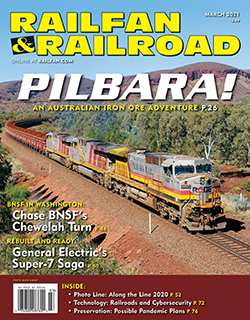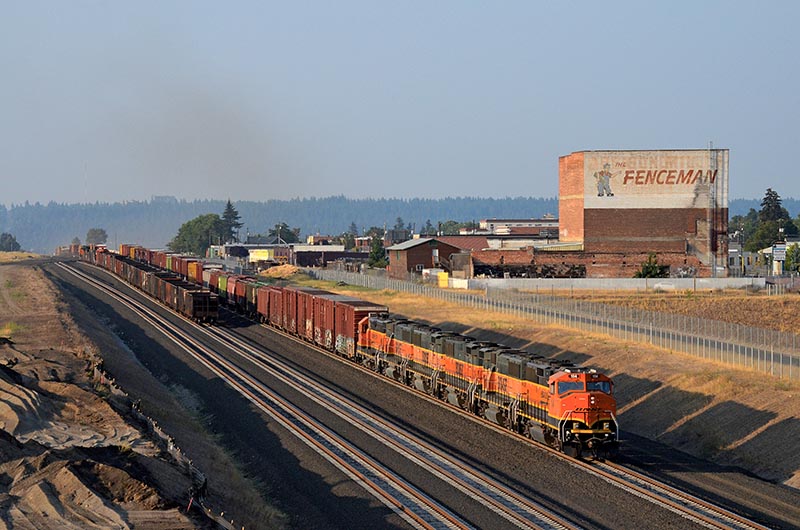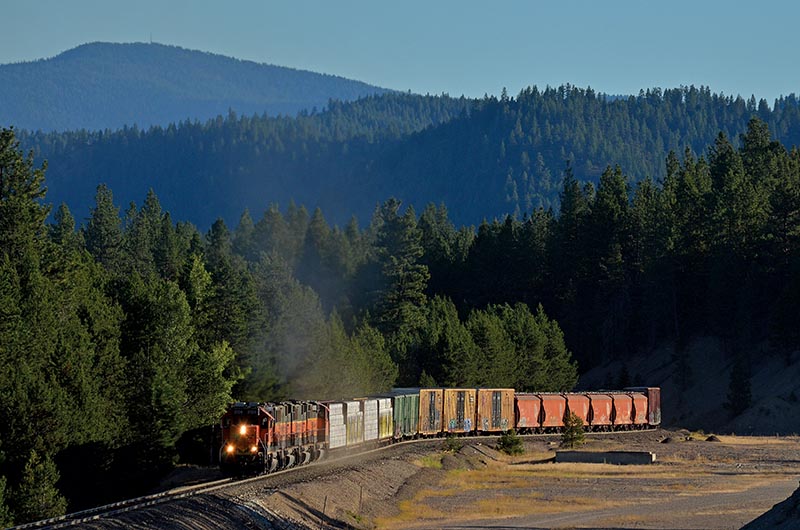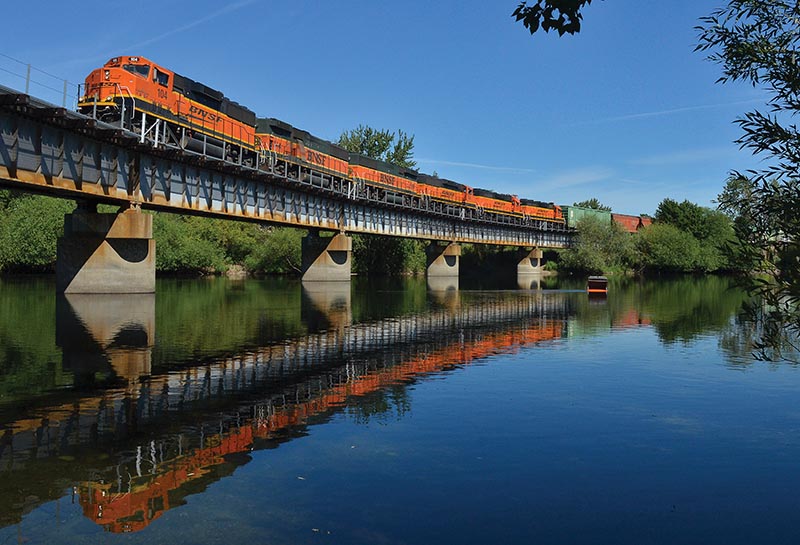 By Bruce Kelly/photos as noted
By Bruce Kelly/photos as noted
A former Great Northern branch that twists its way through pine forests of the Pacific Northwest is a long way from the former Santa Fe main line across the Mojave Desert. And yet, here we are on a Saturday morning near Springdale, Wash., watching an A-B-B-B-A set of EMD GP60s crawl its way up a 1 percent grade with lumber, sand, and empty ore cars on the drawbar. Three decades ago, these units would have been flying through Cadiz, Calif., at close to 70 mph with the hottest of Santa Fe’s intermodal trains. Now they mosey down a goat trail northwest of Spokane, Wash., connecting BNSF Railway with customers located near the Canadian border, on a train known as the Chewelah Turn.
Natural resources amid the mountains and river valleys of northeastern Washington and southern British Columbia lured in rail lines from all directions. Much of that trackage has long since vanished, but this rugged landscape still hosts enough commerce and enough railway to give four-axled locomotives that were once the pride of their fleet a place to spend their golden years. It’s hardly a retirement home; these Geeps still flex their muscles. And they’re not forgotten, having developed a cult following among railfans who seek one of the most unique and well-matched motive power shows on BNSF or anywhere else.
All Eyes on the Northwest
Before BNSF there was Burlington Northern, and before 1970 there was Great Northern, whose visionary leader James J. Hill aimed to build a main line along the northern tier linking the Great Lakes with Puget Sound. Hill realized he would eventually compete against Canadian Pacific for east-west traffic, so he probed northward into Canada wherever possible to gain business. And why not? CP was invading Hill’s turf by piecing together properties that would form Soo Line in the American Midwest.

Six Geeps guide the Chewelah north through Hillyard on the morning of July 29, 2018. Where Great Northern’s shops and yard once stood, BNSF has arranged tracks to serve local industries and to accommodate future expansion of Spokane’s North-South Freeway. Bruce E. Kelly photo
When GN reached Spokane in 1892, Northern Pacific and Oregon Railway & Navigation Company had both been well established there (OR&N would later become part of Union Pacific). Local entrepreneur Daniel Chase Corbin was already three years ahead of Hill in terms of building a line from Spokane north toward Canada. Spokane Falls & Northern Railroad spiked down some 102 miles of track to the Columbia River port of Marcus, Wash., just north of present-day Kettle Falls, during 1889–90. Over the next few years, Corbin extended SF&N into British Columbia, around the same time that CP and GN were converging on that territory from the east and west. NP acquired SF&N in 1898. Later that year, financial restructuring forced NP to sell SF&N to GN.
Hill now possessed the means for branching into southern British Columbia more easily than with the line he was building eastward from Vancouver. During 1899–1900, GN eliminated nearly 15 miles of SF&N’s meandering track north of Mead, Wash., and replaced it with four miles of much straighter track, making Dean, Wash., (just north of Colbert) the new junction between the former SF&N and the GN main line.
Ten miles south of Dean, GN built a large yard and shops complex at Hillyard, its name honoring the company president, yet coincidentally located atop a bluff some 200 feet above Spokane. Better known for manufacturing 2-8-8-2s, Hillyard almost lost its role as a sorter and builder of freight trains to a larger classification yard that GN considered developing near Dean in the late 1960s; that project got dropped in the lead-up to the 1970 BN merger. Hillyard finally succumbed to post-merger downsizing during the 1980s, when BN consolidated its Spokane diesel servicing to the ex-NP facility at Parkwater and switching duties to the ex-NP yards at Yardley and Erie Street.
In 1932, GN operated more than 300 miles of branch lines radiating north from Dean, nearly 100 of those miles being in Canada. Corbin’s completion in 1906 of Spokane International Railway to connect with CP south of Cranbrook, B.C., forged an east-west corridor involving Soo Line, CP, SI, and UP that competed with GN then and remains mildly competitive with BNSF today. Eventually, there was relative peace between GN and CP, the two companies exchanging a wealth of business across the international boundary decades before the North American Free Trade Agreement.

An 81-car M-CWHSPO climbs the 1 percent out of the horseshoe loop approaching Loon Lake on August 22, 2020. Lead unit 3126 was a BN GP50 built in 1985; it’s now a GP25 derated to 2,500 hp. Bruce E. Kelly photo
GN and CP snipped any of their Inland Northwest branches that became unproductive or too costly to maintain. The groundwork laid earlier by D.C. Corbin in British Columbia, however, would help keep his SF&N alive through the GN years, and beyond. Corbin and another American tycoon, Frederick Heinze, went after gold and copper near Rossland, B.C. Heinze established a successful smelter at nearby Trail, while Corbin built a daring rail line called Red Mountain Railway — with hairpin loops and audacious timber trestles — to link SF&N with Rossland. Canadian Pacific secured rail access to Trail from the north as well as control of the smelter by 1898.
Canadian Pacific introduced processing of lead and zinc at Trail, and its delivery of those ores and processed concentrates made Corbin’s RMR serving Rossland from the south virtually obsolete. GN abandoned the RMR line in 1922, but the reputation of GN’s former SF&N trackage as a vital ore-hauling route would be solidified decades later.
In 1989, the Red Dog Mine opened for business in western Alaska, exporting zinc and lead ore globally, much of it bound for Trail. Unfortunately for CP, its most direct lines linking Vancouver with the southern B.C. interior had been evaporating since the 1960s. Thus, the long-term contract for shipping Red Dog ore inland from port landed primarily with BN, its routing from the Vancouver area south to Everett, Wash., east to Yardley, and north to a truck transload just above the border at Waneta, B.C., being mostly of GN heritage. Another point scored for Jim Hill…



